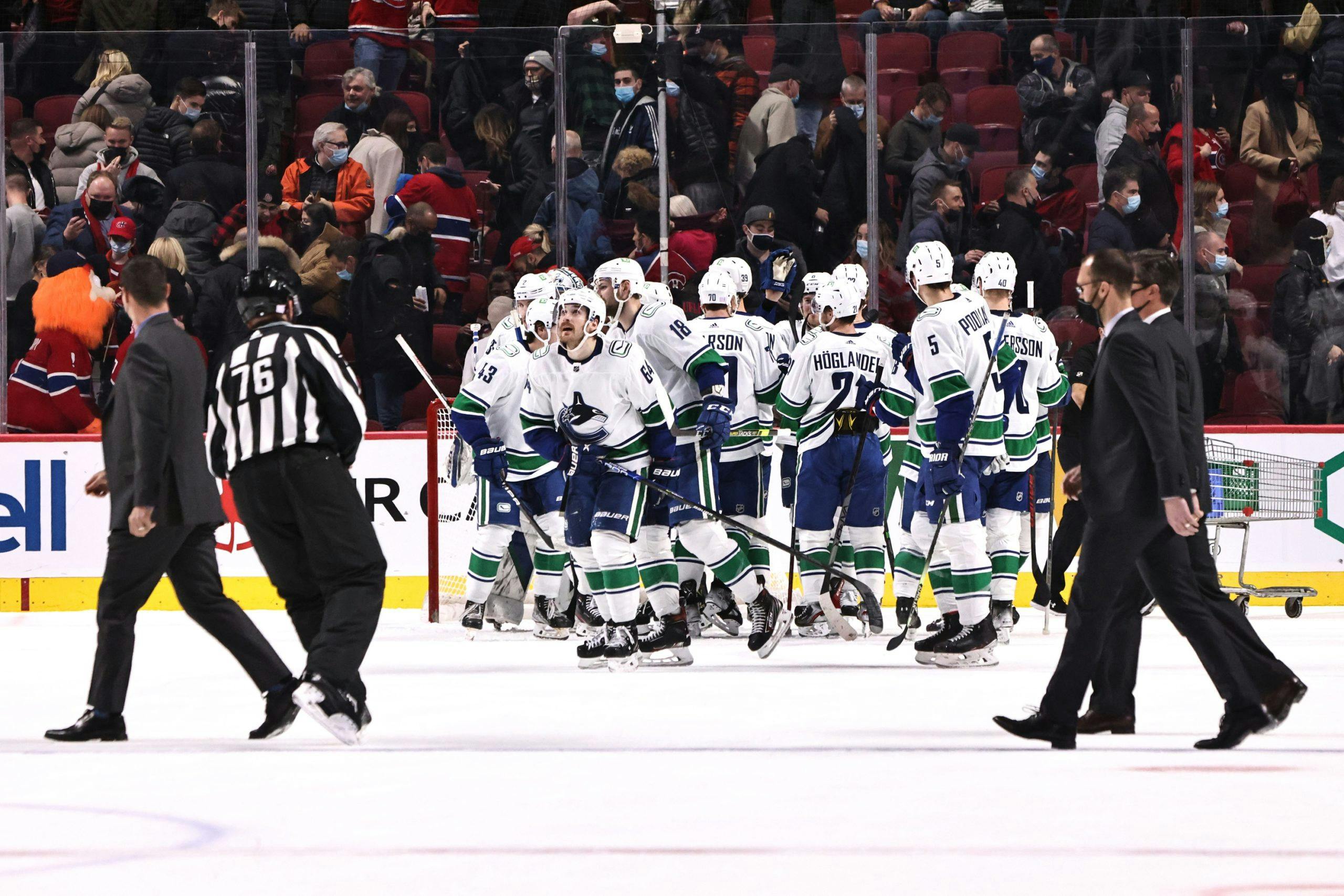Nation Sites
The Nation Network
CanucksArmy has no direct affiliation to the Vancouver Canucks, Canucks Sports & Entertainment, NHL, or NHLPA
A deficiency in prospect and player development has damned the Vancouver Canucks most of all

Photo credit: © Jean-Yves Ahern-USA TODAY Sports
Dec 2, 2021, 14:36 ESTUpdated: Dec 2, 2021, 14:35 EST
The dissection of the Jim Benning Era Canucks is underway in Vancouver.
Or, since nobody has been fired yet, maybe the term we should be using is “vivisection.”
Either way, something’s gone horribly wrong, and fans and media alike already have their scalpels out, ready to dig into this franchise and get to the root of the issue.
Bloody fingers will be pointed at some short-sighted trades, some ill-advised free agent signings, and an overall dearth of draft picks, both in terms of quality and quantity.
That’s entirely fair, and those are all valid points.
But if you really want to cut to the heart of what’s wrong with the current version of the Vancouver Canucks it all comes down to player development — or a distinct lack thereof.
And this count can’t be entirely pinned on Benning alone, either.
Benning became GM of the Canucks in the summer of 2014. Travis Green was already in place as head coach of the Utica Comets, and was promoted to head coach of the Canucks in 2017.
Both have played a crucial role in player development over the past several years, as has Trent Cull, who replaced Green as Utica head coach in 2017 and has since followed the team to Abbotsford.
It just might not be something they want to put on their professional hockey résumés.
Before we dive into the grim and grisly details, we’ll pause to ask the reader to ponder a question:
When was the last time the Canucks organization actually developed a player from the draft, through their minor system, and onto the main roster for a genuine NHL career?
Don’t spend too much time thinking about it. Unfortunately, it’s been a while.
Note that we specifically mentioned “skaters.” The Canucks have been good, and maybe even great, at developing goaltenders in the Benning Era.
The Canucks didn’t draft Jacob Markstrom, but they certainly developed him into one of the best big league goaltenders working today. Markstrom has been replaced by Thatcher Demko, Benning’s third-ever draft pick with the Canucks. Both Markstrom and Demko spent significant time as Utica Comets before graduating to the NHL level — and both Mike DiPietro and Arturs Silovs look to be on a similar track.
Ian Clark and Curtis Sanford have done an exceptional job at developing goaltending prospects for this organization.
If only the same could be said for any players beyond the crease.
Throughout the Benning Era, the Canucks have been blessed with a number of prospects that have arrived more-or-less NHL-ready, and they’ve had plenty of success in transitioning those players onto the roster.
Bo Horvat, a Mike Gillis draft pick, made the Canucks right out of the OHL, playing only five games in Utica along the way.
Same goes for Jared McCann, who cracked the roster as a 19-year-old and was then promptly traded for Erik Gudbranson.
Brock Boeser stepped straight from his sophomore season in the NCAA to the NHL, and he’s never seen a day in the minors.
Neither has Elias Pettersson, who came over after his record-setting Draft+1 campaign in the SHL and proceeded to win the Calder Trophy.
Quinn Hughes arrived the next year, ready-made like all the others.
Even Nils Höglander and Vasily Podkolzin made the Canucks’ opening night roster in their first North American seasons.
All of the above became Canucks without having to spend much, or any, time developing in the minor system. The same could even be said of Troy Stecher and Ben Hutton if you want to go back far enough. The Canucks didn’t really develop them. Teams like the Vaxjo Lakers and the University of North Dakota developed them into NHL-ready players, and the Canucks simply made room for them on the active roster.
But what about those players who can’t crack the NHL right away? Surely, the Canucks have also developed some of those players into genuine big league talents, right?
Surely, the Canucks’ affiliate system is not a veritable pit of despair, into which any prospect, once tossed, is thereafter lost forever in a sea of stagnation and stalled progress?
Surely, the Canucks have developed at least one skater through the minors and into a long-term NHL career, right? Just one? An exception to prove the rule?
The answer is, more-or-less, no.
If there’s a single example to be found, it’s Jake Virtanen, who spent much of his sophomore season with the Comets after a year in the NHL as a 19-year-old. But if we’re going to call the 250 or so games that followed an “NHL career,” it certainly wasn’t an overly successful one.
The Canucks also spent a considerable amount of time trying to develop Olli Juolevi into an NHL blueliner, but that didn’t really work out, either.
Strangely enough, Adam Gaudette may be the greatest success story to be found out of the bunch, but then he only ever played a grand total of 16 games for the Comets.
Zack MacEwen and Jonah Gadjovich might prove to be the first true examples of long-term NHLers that the Canucks have developed through multiple AHL seasons — but, unfortunately, they’ll be proving it for the Philadelphia Flyers and San Jose Sharks, respectively.
If you wanted to be especially generous, you could add any of Brendan Gaunce, Alex Biega, or Darren Archibald to the list, but you probably shouldn’t.
Other than that? Zip. Zero. Zilch. Zalewski.
As we said at the outset, not all of this can be left at Benning’s doorstep. Cull and Green are both worthy of blame as Utica head coaches, and Green also deserves criticism for failing to transition any non-NHL-ready youth onto his NHL roster.
And, if we’re being totally honest, this issue actually extends back past the beginning of the Benning Era and well into the Gillis Era. If you want to find the last everyday NHL player that the Canucks have truly developed, it’s probably Chris Tanev. He first hit the ice for the Canucks back in January of 2011.
That’s a really, really long time to go between developing NHL talents, and the results definitely speak for themselves.
In an ideal situation, a franchise is going to build through the draft, selecting and developing players to fill out the majority of their depth chart at all positions, and not just at the top of the lineup. The Canucks’ complete and total lack of player development has left them severely shorthanded as an organization, and as a result, they’ve had to paper a lot of cracks over.
Those expensive trades and albatross UFA contracts? The constant influx of sub-replacement-level players to staff the bottom-end of the lineup? Those are all direct results of the Canucks not having enough quality players come up through their system, and of having to reach outside the organization in order to even field an NHL lineup.
For any professional sports franchise, that should be unacceptable.
For a team like the Benning Era Canucks, who have spent the majority of the last eight years at the bottom of the standings, it’s darn near inexplicable.
And yet, here we are — still vivisecting after all this time.
Breaking News
- Instant Reaction: Sabres 3, Canucks 2
- Friedman: Brock Boeser expected to play for Canucks against Sabres following appendix issue
- Canucks assign goaltender Nikita Tolopilo to AHL Abbotsford
- Scenes from morning skate: Demko returns, Boeser a game-time decision for Canucks vs. Sabres
- Canucks prospects’ World Juniors chances according to Steven Ellis: Canucks Conversation
